Desert is a barren region of Earth’s surface that receives little rainfall. Some scientists classify a desert as any region where the amount of moisture lost each year—mainly by evaporation—exceeds the moisture that falls as precipitation. Deserts cannot support the diversity of plant and animal life found in humid climates. However, some plants and animals thrive in deserts.
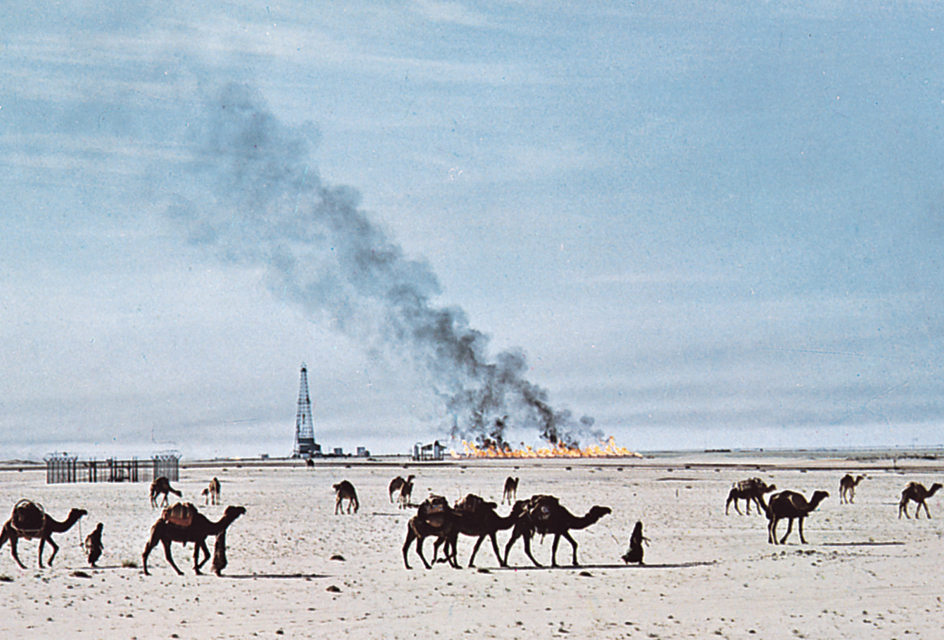
Many deserts have hot climates marked by extremely high temperatures, especially during the day when the sun rises high in the sky. However, scientists refer to some regions near the poles as cold deserts or polar deserts. In these areas, the cold air holds little moisture, and the ground remains frozen all year. Little water remains available to support plant life. This article discusses deserts in warm regions. For information on cold, dry areas, see Antarctica and Arctic (Climate).
Deserts cover one-fifth of Earth’s land. The most extensive deserts lie in the subtropical regions along the Tropic of Cancer and the Tropic of Capricorn. The world’s largest desert, the Sahara in northern Africa, stretches 3.5 million square miles (9 million square kilometers), an area roughly the size of the United States. Scientists consider the Atacama Desert in northern Chile the world’s driest desert. The Atacama Desert averages less than 0.5 inch (1.3 centimeters) of rain yearly.
Deserts cannot support large numbers of people. The dry climate generally restricts farming to river valleys or oases. At an oasis, underground water originating in distant mountain streams comes close enough to the surface for wells and springs to exist. Oases often serve as sites for settlements and irrigated farms. Some desert cities bring in water from far away by canal or pipeline.
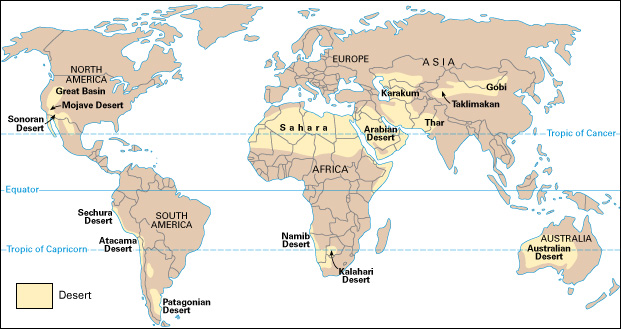
People who live in deserts must protect themselves from high temperatures in summer and, in some cases, from low temperatures in winter. In North American deserts, many people live in houses made of adobe or mud bricks that provide insulation from the heat and cold. Desert herders in Africa and Asia live in tents and wear long robes for protection against the scorching sun and blowing sand. Air conditioning makes life comfortable for many city dwellers in hot desert regions.
Desert climate and land
Subtropical deserts generally receive less than 10 inches (25 centimeters) of precipitation annually. However, the amount of precipitation may vary from year to year, and large amounts of rain may fall within a short period. For example, Death Valley, part of the Mojave Desert in California, averages 2 inches (5 centimeters) of rainfall annually. However, 2.5 inches (6.4 centimeters) of rain fell there between Dec. 27, 2004 and Jan. 9, 2005.
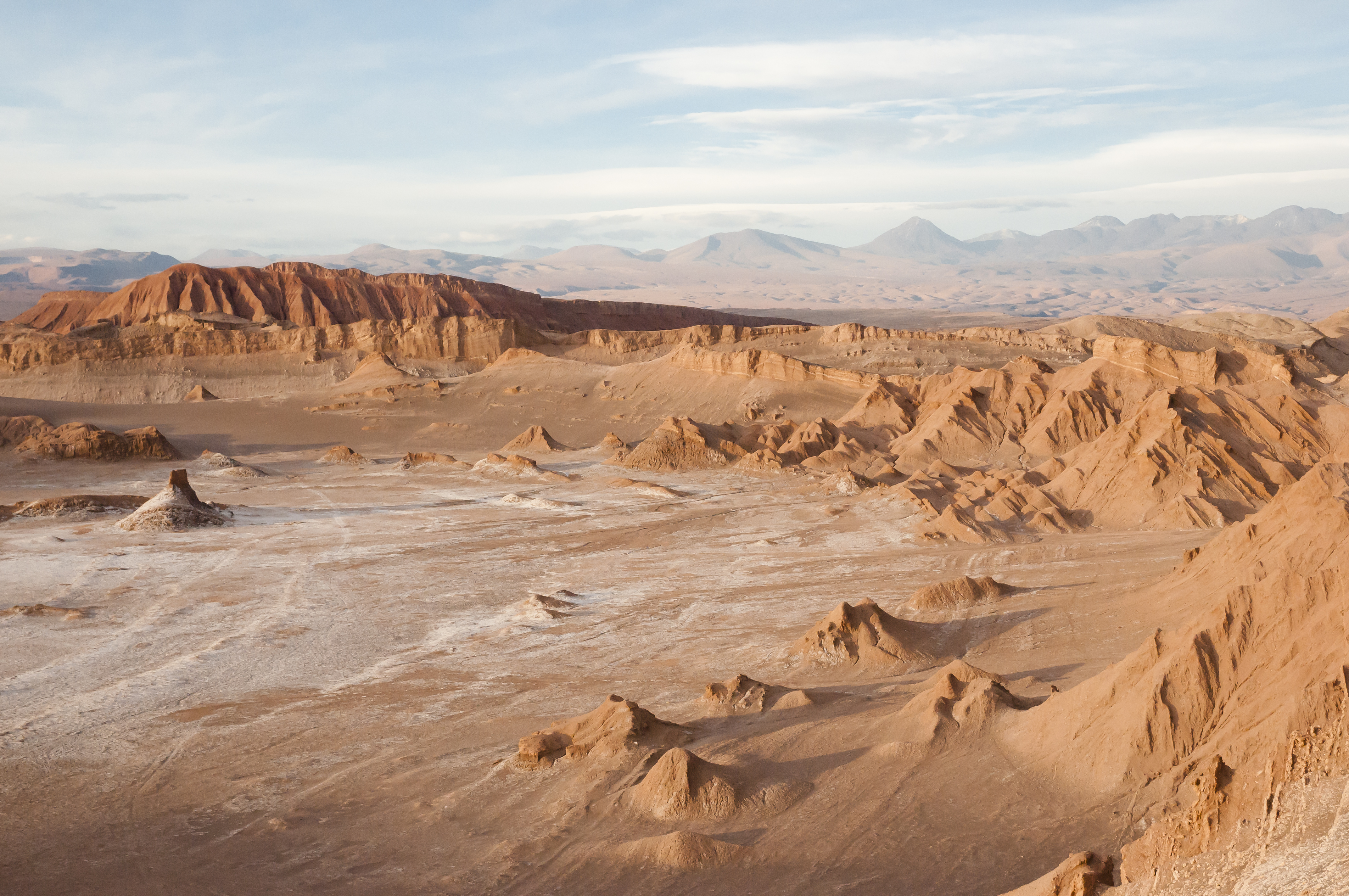
Deserts include the hottest places in the world because they absorb large amounts of heat from the sun. In humid climates, clouds prevent some sunlight from reaching the surface, and evaporating water draws off some of the sun’s heat. In the dry, cloudless desert, summer temperatures often reach 100 °F (38 °C) or higher during the day. At night, temperatures may drop to 45 °F (7 °C) or lower. This dramatic cooling occurs because there are no clouds or water vapor to keep the accumulated daytime heat from escaping into the atmosphere.

Sand covers 10 to 20 percent of most deserts. The rest of the land consists of gravel-covered plains, rocky hills and mountains, dry lake beds, salt flats, and dry stream channels.
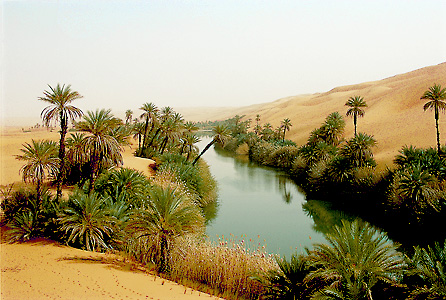
Wind and water erode rock and deposit silt, sand, and other sediments to create various features of a desert landscape. For example, windblown sand and silt particles shape desert stones and boulders into carved rocks called ventifacts. The wind also erodes rock to create sculpted ridges called yardangs. It contributes to the formation of broad depressions in the land by removing fine-grained particles from the surface. One such depression, the Qattara Depression in western Egypt, covers 7,000 square miles (18,000 square kilometers) and drops 436 feet (133 meters) below sea level.
Mounds and ridges of windblown sand called dunes take on many shapes, depending on the winds that create them. For example, crescent-shaped dunes called barchans form in areas where the wind blows from one direction. Long, sharp-crested seif dunes occur in regions where the wind’s direction varies. Sand seas or ergs are vast regions of desert covered with sand and dunes. Sand seas appear in Africa, Asia, and Australia.
Rainstorms and the flow of water from nearby mountainous regions can result in brief flooding that creates other desert landforms. An arroyo or wadi forms when floodwaters cut a deep canyon into the dry desert ground. On occasion, rapidly flowing water fills the canyon. The water slows as it leaves the canyon’s mouth, depositing sediment in a fan-shaped form called an alluvial fan. Sometimes, the canyon carries water into low areas in the desert plains, where it forms a temporary lake. The lake’s water either soaks into the ground or evaporates, concentrating the dissolved salt content and leaving behind a flat, dry bed called a playa.
Life in a desert
Although deserts can appear lifeless, many of them support a surprising variety of living things. During the day, desert plants use special adaptations to avoid losing water. At night, a desert can come alive with animals that spent the daylight hours hiding from the sun’s rays.
Desert plants
grow widely scattered from one another, reducing competition among them for the small amount of water available. Most desert plants have extensive roots that enable them to obtain water and minerals from large areas. The cactus has extremely long roots that grow close to the surface and collect as much water as possible for storage. Some desert plants obtain underground water through roots that extend deep beneath the surface. For example, the mesquite tree has roots that grow as deep as 263 feet (80 meters).
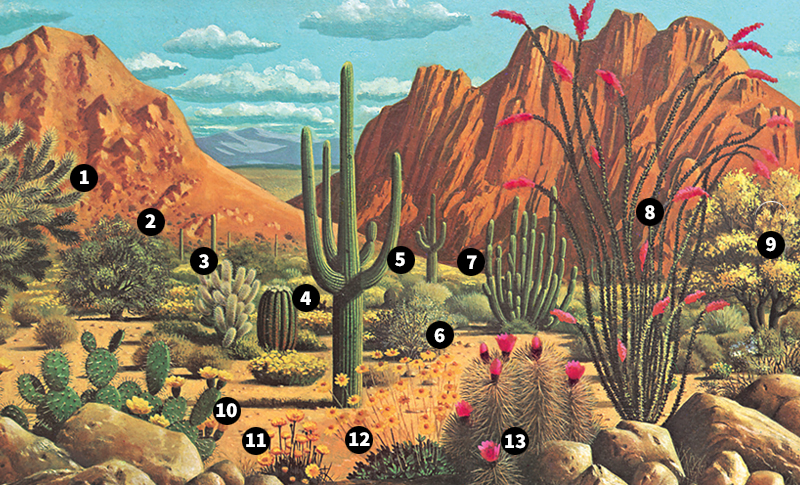
High desert temperatures can cause plants to lose a great deal of water from their exposed surfaces through evaporation. For this reason, many desert plants have a thick stem with waxy skin. The fleshy stem holds water, and the skin keeps the stored water from evaporating. A cactus also has spines on its stems that provide some shade for the plant and help to limit water loss. Some plants, such as the prickly pear cactus and the agaves, only open their stomata at night when evaporation rates are lowest. Stomata are openings through which water from inside a plant evaporates, cooling the plant and enabling it to draw more water from the ground.
Rare heavy rainfalls in the desert can result in a remarkable blooming of colorful flowers in just a few days. This dramatic flowering occurs because many desert plants do not grow in dry periods. After a rainfall, these plants quickly sprout, flower, and die.
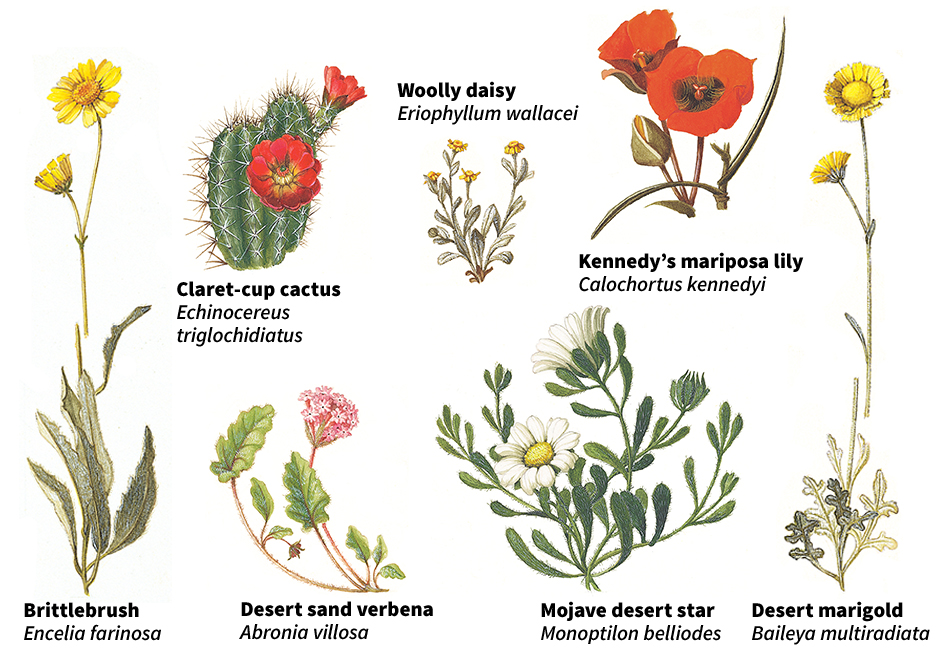
Desert animals
include many kinds of insects, spiders, reptiles, birds, and mammals. After a rainfall, deer, foxes, wolves, and other animals may visit a desert in search of food. Snakes and lizards thrive in the warm desert climate.

Most desert animals avoid the extreme daytime heat by feeding at night, after the temperature drops. Many small animals dig burrows underground and stay there during the day, while larger animals stay in shady areas.
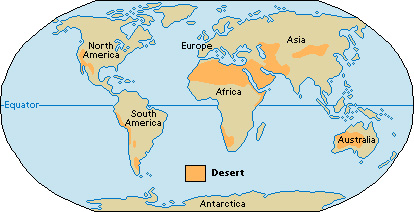
Among larger animals, the one-humped Arabian camel, also called the dromedary, adapts to desert conditions in various unique ways. It can raise its body temperature to reduce perspiration and can also survive for days or even weeks with little or no food or water. When food becomes scarce, fat stores in the hump provide energy for the animal. The camel’s stomach and intestine slowly release stored water into the animal’s bloodstream when water becomes unavailable.
How deserts develop and change
Deserts tend to form where cool air, which can hold little moisture, grows warmer, producing hot, dry conditions. Most deserts occur between the latitudes of 15° and 35°, in the zones of high atmospheric pressure that lie on either side of Earth’s equator. There, cool, dry air descends and becomes warm, producing desert conditions. Regions separated from the ocean by mountains also tend to be dry. A moist wind blowing inland from the ocean grows cooler as it rises over mountains, losing its moisture as fog, rain, or snow. As the wind descends the opposite side of the mountains, it becomes warm and dry, sometimes forming a desert. Cold ocean currents flowing next to land can create coastal deserts. These deserts form because the cool winds that blow across the water and onto the land carry little moisture.
Changes in climate can cause changes in the location and extent of deserts. Scientists believe that many of the world’s subtropical deserts have formed and expanded since the end of the last ice age, about 11,500 years ago. Before that time, the subtropical regions had greater moisture and cooler temperatures. Today, these deserts appear to be expanding. This expansion may result in part from global warming, a rise in worldwide temperatures linked to human activities. See Global warming.
Other human activities have also caused deserts to expand. The development of cities, excessive grazing by livestock, and certain other farming practices have reduced plant cover near desert borders. Without the protective cover of plants, wind and water erode the soil, causing a desert to expand. This continual loss of fertile land along the edges of deserts is called desertification.
Desertification presents a serious problem because the loss of land suitable for farming can lead to famine. Improving farming methods and limiting the amount of livestock kept in areas close to deserts may help reduce the expansion of deserts.
